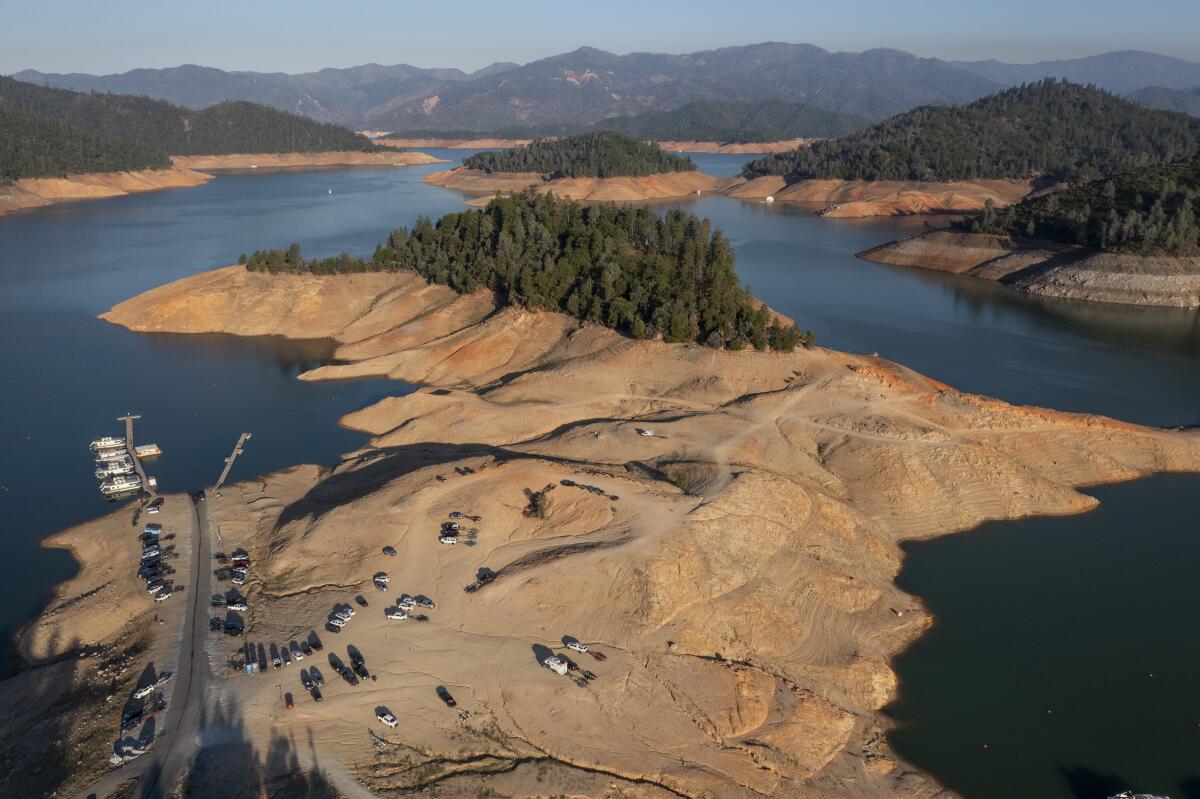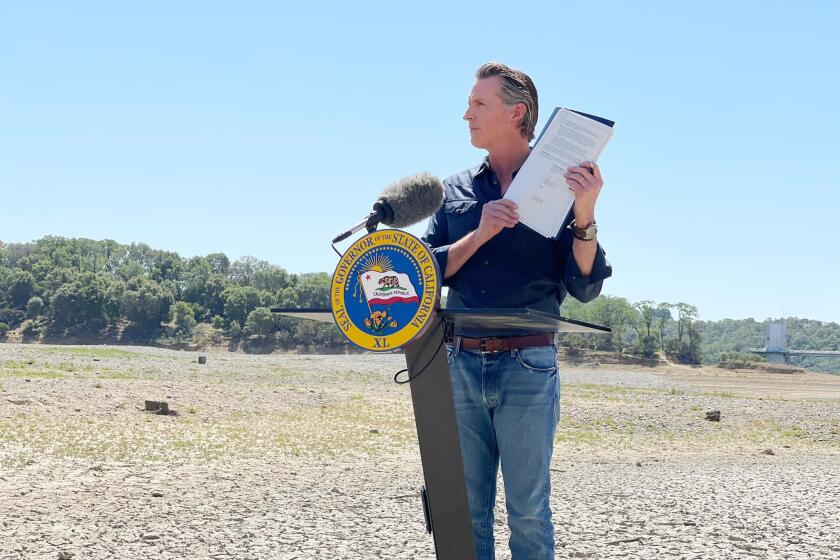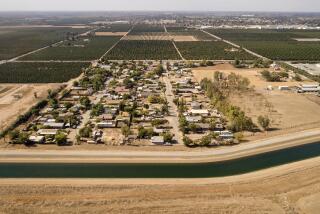Column: This proposed ballot measure would make you pay for the ag industry’s water inefficiency

Whoever coined the phrase “Whisky is for drinking, water is for fighting” didn’t have things quite right.
In California, water is for scamming. The newest example is a majestically cynical ploy being foisted on taxpayers by some of the state’s premier water hogs, in the guise of a proposed ballot measure titled the “Water Infrastructure Funding Act of 2022” — or, as its promoters call it, the More Water Now initiative.
The measure’s backers need to gather nearly 1 million signatures to place it on the November 2022 ballot. That process has just begun, and its outcome is uncertain.
“This proposed initiative is a desperate throwback to the idea that there is still more water that can be extracted from California’s already massively overtapped rivers and aquifers.”
— Water expert Peter Gleick
But the initiative is so costly and dishonest that it’s wise to nip it in the bud now.
The measure could wreak permanent damage to the state budget and force taxpayers to pay for ecologically destructive and grossly uneconomical dams, reservoirs and desalination plants.
Get the latest from Michael Hiltzik
Commentary on economics and more from a Pulitzer Prize winner.
You may occasionally receive promotional content from the Los Angeles Times.
It would also undermine the authority of state judges and environmental regulators, and gift growers and dairy ranchers with millions of acre-feet of effectively free water. (An acre-foot is about 326,000 gallons, or enough to serve one or two average households for a full year.)
The initiative’s proponents say it’s needed to provide “clean, safe drinking water for homes and businesses, water for agricultural use, and treatment, purification, and reclamation of storm water and wastewater, while maintaining protection for the environment.”
In reality, “it’s really a bait-and-switch,” says Doug Obegi, the California water expert at the Natural Resources Defense Council.
“It significantly undermines environmental protections for fish and wildlife,” Obegi told me, “and raids the state’s general fund to subsidize new water projects that would predominantly benefit industrial agriculture in the Central Valley.”
Here’s the background.
The drought isn’t going away, and it will drastically alter California and the West.
There’s no disputing that the state faces a multifaceted water crisis. The problem is partly bequeathed us by reality: Our natural sources of water — rivers, groundwater and rainfall — are all oversubscribed as a result of explosive population growth and increased demand from industrial and agricultural users.
The problem also stems from policy, or, to be precise, a failure of policy. California has never found a way to balance the competing demands of urban residents, growers and ranchers, and the environment to ensure that all have equitable access to clean and reliable water.
The agriculture industry is the epicenter of the problem: It consumes 80% of the water used every year in California by homes and businesses.
Since 1990, the volume of water used by farmers and ranchers has remained flat while the value of agricultural production has soared. But the sector has the potential to reduce usage by as much as 22% through more efficient usage without affecting productivity, according to the Pacific Institute.
Urban use, meanwhile, has plummeted, although residential users have pared back their conservation efforts in recent years. From 1990 through 2015, urban usage fell by almost 40% despite population growth.
The consequences of drought are already being felt around the state, if unevenly. “Back in 2019, we turned on our faucet and there was no water,” Martin Chavez, a board member of the Stratford Public Utilities District in the Central Valley, told me. “For weeks we were without water.” This was not merely an inconvenience. It meant no work for the largely immigrant local population of farmworkers.
The relentless funneling of water to California agricultural users may help feed the country — and the world — but it has left the environment parched.
Releases of water for irrigation from Shasta Dam in the far north of the state raised the temperature of water in the Sacramento River downstream and effectively cooked salmon eggs and fry to the point that the salmon fishery is facing a loss of 90% of the fish population this year, said Barry Nelson, a consultant to the fishing industry.
Other Northern California water courses have been exploited to the limit. That has helped make California “a global hot spot for fish extinction,” Nelson says.
The question is not whether there is a crisis, but what to do about it. The preferred solution of agricultural water users in the Central Valley, the state’s breadbasket, has been to build more dams and larger reservoirs.
That brings us to the More Water Now initiative.
The measure aims to fund a wide range of water projects — underground storage; storm-water and wastewater recycling; expansion of existing reservoirs and construction of new ones, including through construction or raising of dams; desalination plants; and pipelines.
Wall Street has just found a way to profit from California’s water scarcity.
But it’s really aimed at capital-intensive public works. That said, it requires nothing in the way of cost-benefit analyses of the sort that have helped to quash several extremely wasteful and overly costly projects such as the Temperance Flat dam in the Central Valley. Conservation, which is really the key to sustaining California in the modern drought era, would get short shrift.
“This proposed initiative is a desperate throwback to the idea that there is still more water that can be extracted from California’s already massively overtapped rivers and aquifers, and that the way to do it is with old, damaging 20th century infrastructure of dams, diversions, and expensive centralized systems,” says Peter Gleick, one of the state’s leading experts on water.
The state’s ability to build these systems is a relic of the past. Dams are now understood to be environmentally disastrous and generally in the red on a cost-benefit basis. “There aren’t any great proposals left to build dams and reservoirs,” says Jonas Minton, senior water policy advisor at the Oakland-based Planning and Conservation League. “They’ll just keep chasing less and less water.”
The measure’s genesis is a little murky. Edward Ring, a conservative political commentator who is one of its spokesmen, says it originated among a small group of civic-minded volunteers — people “with no ulterior motive whatsoever other than to do something to help this state.”
That may be so, but it sure doesn’t smell that way. Of the eight businesses listed as endorsers on the campaign’s website, seven are agribusinesses and one is a home builder. Three business associations are listed as endorsers — the California Milk Producers Council, the Tulare County Farm Bureau and the California Water Alliance, which names three big agricultural businesses as its sponsors.
The committee has disclosed only $78,500 in contributions thus far, a pittance compared with the millions of dollars that will be needed to pay for signature-gathering. But it’s still very early. If the endorsers start putting their money where their mouths are, the war chest will be formidable indeed.
One mystery: Ring told me that the initial funding for the initiative’s drafting by Thomas Hiltachk, a legislative drafting ace who is typically associated with conservative campaigns, came from a nonprofit organization he wouldn’t identify. Whoever it is, however, may well have fingerprints on this effort as inky as some of the identified backers.
The initiative proposal represents an enormous, potentially open-ended commitment to building new water infrastructure, funded in ways that could give those projects priority over other state needs, including social programs and police and fire protection.
It would sequester 2% of the state’s annual general fund budget to those projects; that would work out to as much as $4 billion a year for decades, by the estimate of the Legislative Analyst’s Office.
Joe Biden’s election points to historic gains in the fight against climate change.
That may not be such a big deal when the state is swimming in revenue, as it is now. But when money dries up, the 2% requirement would still exist, shouldering aside almost all other budget needs. Only funding for schools and community colleges, which have their own budget protections, would be immune from the possible effect.
The allocation would continue until the state provided for 5 million acre-feet of additional water supply. The amount that could be counted against the target from conservation would be limited to 1 million acre-feet. Even if Californians gained twice or three times that amount through efficient water use, the initiative would still require spending enough to produce 4 million more from other means.
It’s hard to paint a useful picture of how huge a commitment is represented by 5 million acre-feet in new supply.
The State Water Project, the foundations of which were laid in the 1960s at a capital cost that would come to well more than $50 billion today, comprises 36 reservoirs and other storage facilities, 26 dams, 21 pumping plants and 700 miles of canals, tunnels and pipelines. Yet it still can provide a maximum of only 4.2 million acre-feet of supply a year.
The water project’s annual water allocations have fallen well short of that in recent years — only about 210,000 acre-feet this year and a projected allocation of zero next year, largely because the state is in a long-term drought. That’s an indication of how difficult it will be to squeeze an additional 5 million acre-feet out of the stones that are California water sources.
The Legislative Analyst estimates that the cost of building out this infrastructure will exceed $100 billion.
More troubling is the initiative’s attack on regulatory oversight. Its text says it aims to “streamline” administrative and judicial review of water projects. That’s code for “eviscerate.”
The measure would allow its principal administrative body, the California Water Commission, to declare almost any projects to be exempt from the California Environmental Quality Act, the 1970 statute that requires major projects to meet environmental standards. CEQA has long been a bugaboo of real estate developers, which should tell you where this idea comes from.
Trump’s water giveaway to his rich backers will parch the rest of the state.
Environmental regulators would be given only days to evaluate construction permits of potentially monumental complexity. Coastal Commission rejections of water project permits could be summarily overruled by the state’s secretary of natural resources, a threat to the public interest if an environmentally insensitive governor were to take office.
Court review? Forget about it. Judges could block projects only if they were found to adversely affect “important historical, archaeological, or ecological values” on the project site itself. There would be no cause of action against a dam or reservoir project that might cause environmental devastation well downstream, as often happens.
“It’s written to eliminate environmental protections,” says Barry Nelson, a consultant to the salmon fishing industry.
Finally, there’s the question of who foots the bill for these billions. The answer is it’s you. For decades, the governing principle in water infrastructure is that water users pay for the projects that benefit them.
The initiative would throw that principle away. The projects it funds would be paid for by taxpayers, either directly or through debt service on state bonds floated for construction. Central Valley agribusinesses would find their water supplies enhanced, but the bill would land in everyone else’s mailboxes.
The More Water Now initiative is presented as a solution to a problem that it can’t solve. That water supplies can’t be conjured from the ether is a well-understood fact that agricultural users insist on ignoring, at everyone else’s cost.
The initiative, in Gleick’s words, is “an effort by a small group of Central Valley water buffaloes to grab even more water from the public and the environment, using public money.” The campaign to kill it should start now.
More to Read
Get the latest from Michael Hiltzik
Commentary on economics and more from a Pulitzer Prize winner.
You may occasionally receive promotional content from the Los Angeles Times.










